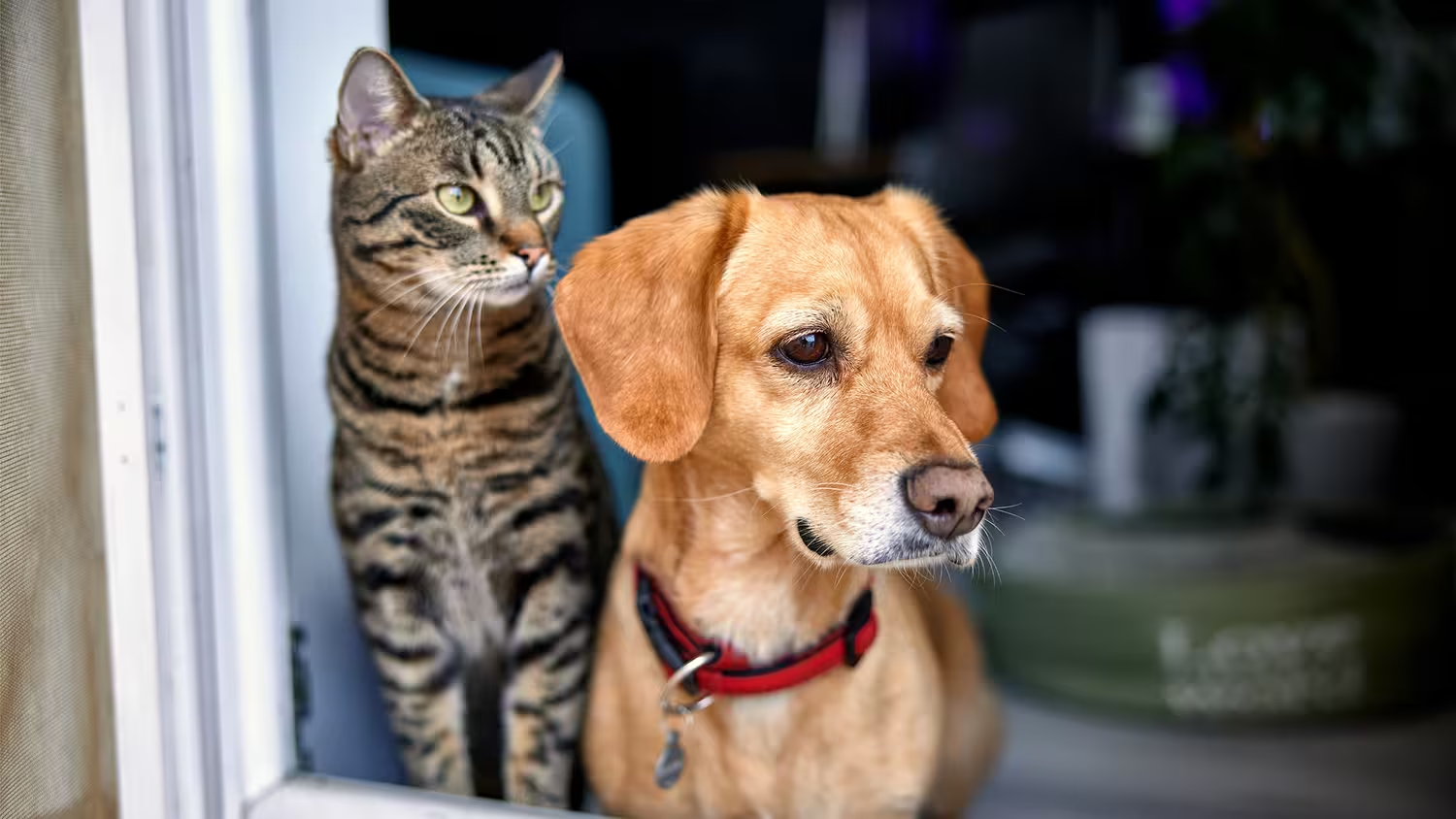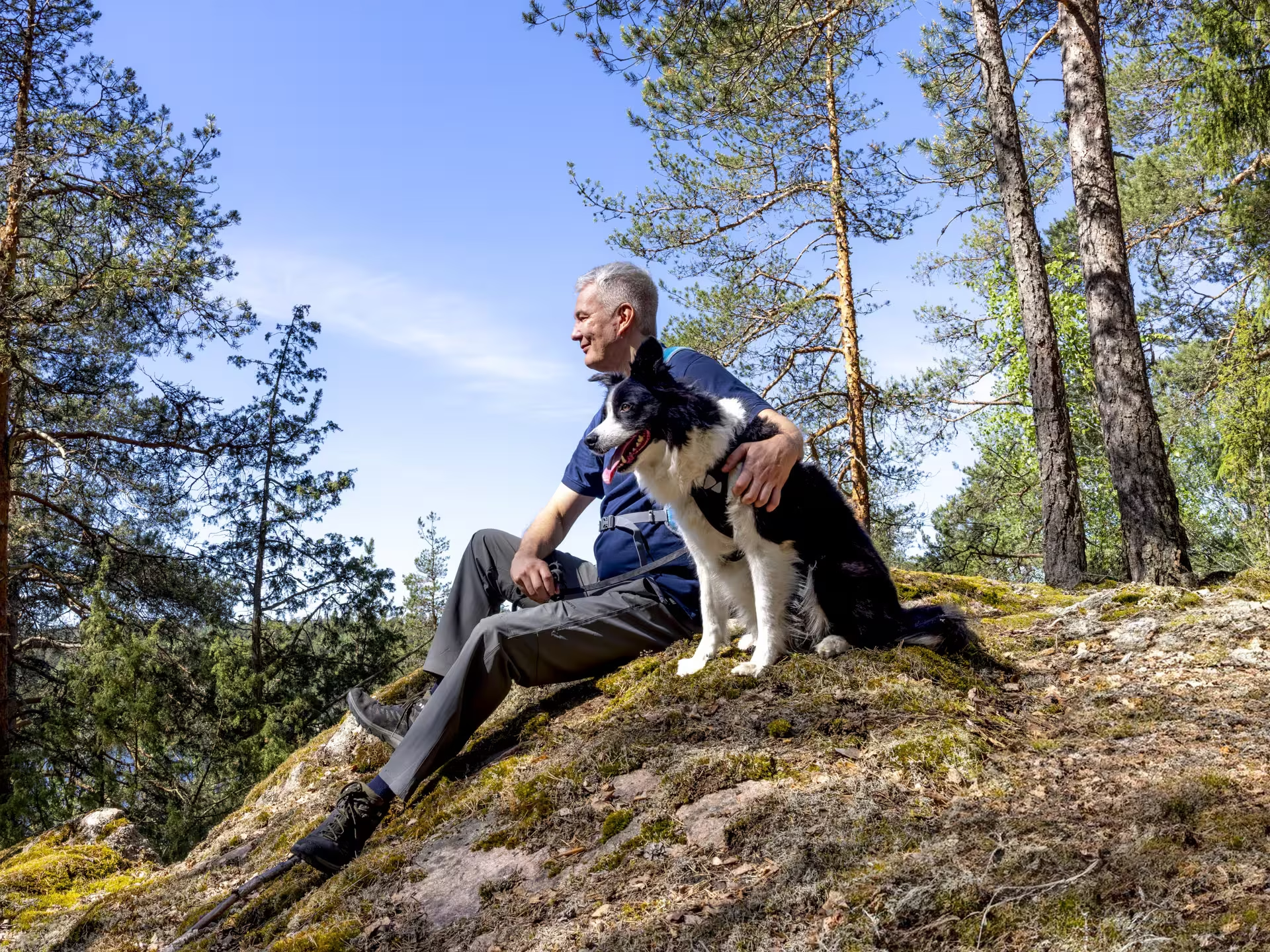1. You show your dog affection by hugging them
The next time you lean in to give your dog a hug, watch for signs such as:
-
turning their head away
-
yawning
-
licking their lips
-
or even licking your face.
These are stress signals that indicate that hugging may be uncomfortable and confusing to your dog.
“This is because, in dog world, they move closer to their bonding group*, as a way to protect themselves when danger is near,” explains Dr. Gonçalo Da Graça Pereira, world-renowned expert in veterinary behavioural medicine.
*A “bonding group" is a term used to describe a group of dogs who have formed social bonds with one another.
So, from a dog’s perspective, hugging can feel like a threatening signal.
“Of course, some dogs tolerate hugging and can even associate it with something positive. But overall, hugging is a complicated way to show your dog you love them,” Dr. Pereira adds.
If your dog doesn’t mind being hugged, you may notice signs that indicate they’re relaxed. These include for example:
-
an open and relaxed mouth (not panting)
-
a relaxed tongue
-
relaxed ears
-
relaxed facial expression.

2. You assume that your cat likes being petted
Our first instinct when a cat comes near us is often to reach out and show affection by petting them.
But beware: your cat may not want to be touched. If their ears flatten and their tail moves, it means they are experiencing emotional conflict. They may want to be near you, but that doesn't mean they want to be petted.
“The cat is very politely asking you to stop,” Dr. Pereira points out, referring to these subtle but important body language cues.
If you continue petting despite these signals, the cat will likely choose between running away or biting you.
Of course, this doesn’t mean your cat doesn’t care about you. Cats simply speak a different language than humans. Even something as simple as raising their tail when you come home is their way of saying hello.
"Rubbing against your legs, grooming you, touching noses, and even sleeping next to you are all signs that your cat has formed a bond with you,” Dr. Pereira describes.
3. You ignore your dog’s anxiety not to reinforce it
Things like fireworks or cars can make a dog feel anxious. However, positive events, such as the caretaker coming home, can also cause anxiety.
You can tell your dog is anxious if it is licking its lips, yawning, or panting, for example.
Some people choose to ignore an anxious dog, believing this will prevent them from reinforcing the dog's behaviour.
“We know nowadays that ignoring the animal when we return home is actually cruel,” Dr. Pereira says.
It turns out that negative emotions cannot be reinforced in this way. This is why it's always better to train an alternative behaviour — one that has previously been taught using positive reinforcement — to help shift your dog’s emotional state.
At the same time, it’s perfectly okay to comfort your dog when they’re feeling anxious.
"Imagine an earthquake starts and I will give you your favourite chocolate cake. It might not do anything, or it can distract you from the event, but the cake definitely won't make you more anxious."
4. You make your cats share a cat litter box and feeding station
If you have a multi-cat household but only one feeding station, this can cause problems in the long run.
"Food is an important resource, and while we see cats sharing it, there can still be underlying tension. This tension can become the root of future behavioural problems between the two cats.”
This is because cats are naturally territorial, and they consider food to be a valuable resource. Sharing a food bowl can therefore cause stress.
The same goes for the cat litter box. Most cats don’t feel comfortable sharing it with others. This is why it's important to provide enough resources for all your cats.
"In the past, we followed a general rule: the number of cats, plus one. So, for two cats, you’d need at least three litter boxes,” Dr. Pereira explains.
“But nowadays, we also need to consider the importance of location. For example, each litter box should be placed in a different room to help prevent tension or competition,” he clarifies.

5. You assume your dog knows when it has done something wrong
Remember the last time you came home and discovered your dog had chewed up your favourite chair or knocked over a houseplant?
If your dog looked “guilty”, chances are they have no idea why.
“If your dog looks guilty, it's because they can sense, even from very subtle facial expressions that you cannot control, that you are unhappy with them”, Dr. Pereira explains.
The dog has no idea it has done anything wrong. The best thing to do in situations like this is to take a deep breath and act normally.
“If you punish the dog, it will create a negative association between your arrival and the punishment,” Dr. Pereira says.
6. You take a second cat so that your current cat doesn’t feel lonely
Although well-meaning, introducing a new cat to your home can sometimes backfire. Many cats may not feel comfortable sharing their territory with a new, unfamiliar cat.
This is because cats lack the social strategies needed to resolve conflicts. As prey animals, they have evolved to hide emotions such as pain as part of their survival instinct.
Cats that live under the same roof can form social groups, making cohabitation easier for them.
“Often, the easiest social groups consist of cats from the same family, especially females, such as a mother and a daughter, or an aunt and a niece. Two males can be more difficult — though not impossible — especially if they are neutered."
Signs that cats belong to the same social group include:
-
grooming each other
-
rubbing against each other.
“If the two cats come from different social groups, but there are enough resources and they are distributed correctly, they may still tolerate each other’s presence”, Dr. Pereira points out.
7. You make sure your dog knows you are the alpha
Some caregivers believe that they need to show their dog that they are the leader of the pack.
This is unnecessary because dogs do not organize their social structure along a linear hierarchy, explains Dr. Pereira.
"Even among wolves, the social structure isn’t based on a single dominant individual. Dogs, on the other hand, have a very different kind of social structure. For example, different individuals may be dominant over different resources."
Additionally, dogs don’t perceive people as dogs. The caregiver trying to dominate their pet is only confusing and stressful for the dog.
“It doesn’t make sense in their language,” Pereira says.











